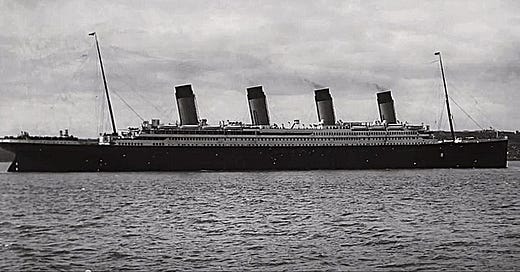Titan and Titanic: Types of Engineering Judgment
In yesterday’s post, The Titan and the Titanic, we compared the Titan and the Titanic incidents. We also discussed the importance of engineering standards. The post received quite a few comments, so I thought that I would provide a few more thoughts on do with rules, standards and the role of engineering judgment.
Engineering Judgment
Both incidents involved poor engineering judgment, but those decisions were of a different type. As we said yesterday, poor engineering judgment was a key factor in the sinking of the Titanic. However, the designers of that ill-fated ship did not fail to follow engineering standards because such standards had, by and large, not been written. For example, the American Society of Mechanical Engineers (ASME), although formed in the year 1880, did not publish its first seminal boiler code until 1915, three years after the loss of the Titanic. Indeed, as we noted yesterday, it was the Titanic tragedy that led to the development of the Safety of Life at Sea (SOLAS) standards.
The loss of the submersible Titan also involved poor engineering judgment, but of a different type. The rules and standards for the design, construction and operations of vessels such as the Titan are mostly in place. The poor judgment involved a decision to not follow those standards.
Now, let us be clear, managers have the authority to over-ride engineering standards. Indeed, such authority is a key part of their job description. However, such decisions are generally made in an emergency situation. (The decision that the authorities made to deliberately set fire to a tank car of vinyl chloride may, on reflection, turn out to have been a mistake. But the people involved were making real time, emergency decisions. Such was not the case with regard to the Titan.)
We see therefore a key distinction between the Titan and the Titanic sinkings. Both involved engineering judgment, but they were different types of judgment.
The Titan designers, based on what we have learned to date, chose not to follow all pertinent standards and rules. The Titanic designers, on the other hand, had only engineering experience to draw on. Very few rules or standards were in place.
Note: The observations to do with the Titan are based on preliminary reports. It will presumable be many months before we see the formal reports, which will help confirm or deny such conclusions.
Performance-Based Regulations
There is one important area in which judgment is not only allowed but is actually called for. Some regulations — the Process Safety Management standards come to mind — are inherently performance-based and non-prescriptive. The agencies involved do not issue detailed standards or rules. Instead, they say,
Do whatever it takes to be safe. You know more about your facility than we do, so you — the managers of that facility — will have to set your own standards.
But even in this situation, the managers are not free to ignore the rules and standards that they created.
The Golden Rule
Further thoughts on why incidents such as the loss of the Titan occur are to be found in the post Titan: A Reflection of Our Insanity. That post quotes John Michael Greer,
Crackpot realism is one of the downsides of the division of labor. It emerges reliably whenever two conditions are in effect. The first condition is that the task of choosing goals for an activity is assigned to one group of people and the task of finding means to achieve those goals is left to a different group of people. The second condition is that the first group needs to be enough higher in social status than the second group that members of the first group need pay no attention to the concerns of the second group.
It can be difficult for engineers and other professionals to convince their managers to slow down and make sure that the rules, standards and regulations are being followed.
Conclusions
The above discussion suggests the following conclusions:
We need independent, objective engineering standards that are issued by an outside organization (such as ASME, API or ANSI).
If an engineer, manager or executive chooses not to follow a standard then he or she must clearly state the reasoning behind their decision. In other words, they must conduct a risk analysis.
In general, the decision not to follow an engineering standard is only justified during an emergency situation where time and safety are critical factors. The need to speed up a project or to cut costs does not provide sufficient justification.
Engineers and other professionals need to be given sufficient authority and status so that they can challenge those managers who may want to cut a few corners.






